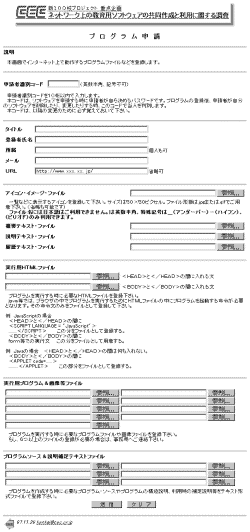 |
| Figure 1.A Screeen from the software controlling system to register
software URL: http://www.cec.or.jp/kenkai/touroku/js-ysinsei.html |
Conference to introduce results from the 100-School Networking Project (Phase
II)
Theme meeting
|
Group leader |
Kazuo Tenra, Tokyo Metropolitan Komaba High School |
|
Committee member |
Junji Sumi, Tokyo Metropolitan Kokusai High School |
|
Committee member |
Nobuhiro Kinase, Shibuya ward Sasazuka Junior High School |
|
Committee member |
Takahiro Haga, Junior High School attached to Faculty of Education at Chiba University |
|
Consultant |
Saburo Oono, Nihon Sun Micro Systems K.K. |
|
Consultant |
Hidetoshi Ogata, Microsoft Co., Ltd. |
 |
| Figure 1.A Screeen from the software controlling system to register
software URL: http://www.cec.or.jp/kenkai/touroku/js-ysinsei.html |
 Conference to introduce results from the 100-School Networking Project (Phase II)
Conference to introduce results from the 100-School Networking Project (Phase II)